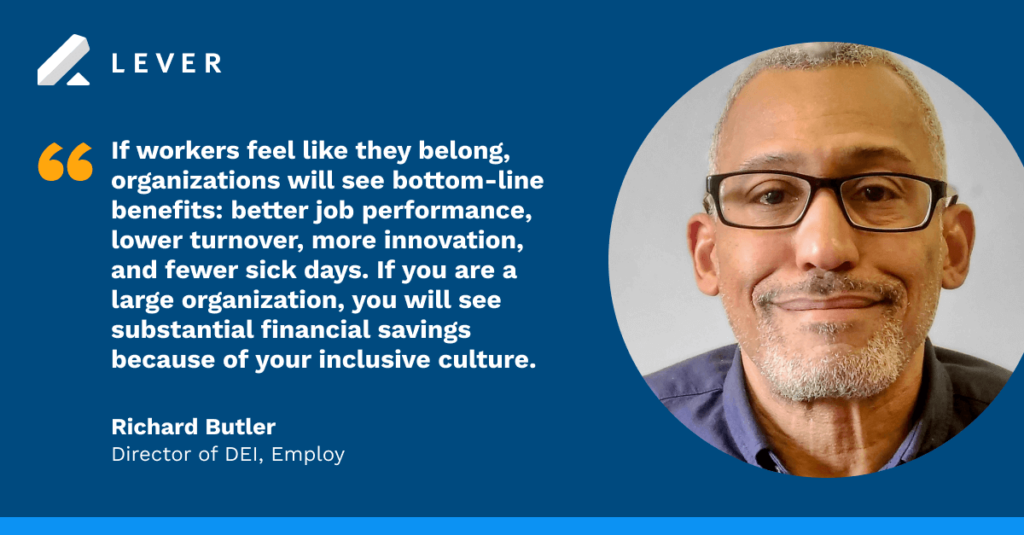Diversity, equity, and inclusion (DEI) efforts are finally beginning to get the attention they deserve, and 35% of hiring decision-makers expect to increase investment in this area.
Then doing so, it’s so important to make the investment in the areas that will make the biggest impact — and that will vary by company.
For some, investing in sourcing a diverse candidate pool is the most worthwhile investment while, for others, software or training to combat unconscious bias will make the biggest impact.
In some cases, investing in inclusive employee benefits and perks can help you attract and retain candidates from underrepresented minorities.
How inclusive employee benefits and perks can influence and support your diversity efforts
To be sure, leverage your data to uncover and prioritize your greatest opportunities for improvement.
A good way to determine whether your benefits are up to snuff is to survey your employees and candidates.
For instance, include questions around benefits in your employee engagement surveys and exit interviews, and track the reasons candidates decline your offers.
If you feel confident that more inclusive employee benefits and perks could improve your workforce diversity, read on for six ideas to get started.

1) Floating holidays
Not everyone celebrates Christmas, but it is typically one of the holidays businesses offer to employees. Support people of varying cultural and religious backgrounds by offering floating holidays to use as they wish.
This can be a great opportunity to stand out to candidates, as 55% of companies do not offer this workplace benefit. One in six offer one day per year, while 13% offer more than two days.
2) Ample paid time off
Ample paid time off can be offered instead of, or alongside, floating holidays to attract employees with diverse cultural and religious backgrounds.
Many religious holidays fall mid-week, so it can be particularly beneficial to those who travel long distances to see family. It would also be appreciated by working parents who are navigating school breaks and sick children.
A full-time employee gets an average of 11 days off after a year, 15 days off after 5 years, 18 days off after 10 years, and 21 days off after 20 years.
When 53% of employees who get paid vacation would leave for more at another company, you can attract diverse candidates by using a competitive paid time off policy as an employee perk.
3) Remote work
A whopping 80-90% of the U.S. workforce says they would like to telework at least part-time. While this benefit would entice most people, it is particularly useful to some candidates from underrepresented groups.
For instance, disabled and semi-retired professionals may prefer to work from home to reduce workplace challenges and eliminate an unnecessary commute.
Working parents would also benefit, as the time they save traveling to and from the office could be spent with their children instead.
In addition, offering remote work allows you to recruit talent from anywhere in the world. That gives you a bigger talent pool from which to build a diverse workforce — even if your geographic location isn’t particularly diverse.
Not only will this benefit not cost you anything, but it could also actually save you $11,000 per employee each year.

4. Flexible schedules
Ditching the traditional workday in favor of flexible schedules can also help you attract and retain working parents, older workers, and some disabled professionals.
This flexible perk is a great way to attract a wide range of talent.
For instance, offering parents the option to begin at 6:00 a.m. means they can be finished with work in time for school pickups.
Older workers may just enjoy working hours that better align with their energy levels and sleep schedules.
And those with frequent medical appointments during the workday may be drawn to an opportunity that allows them to work around those appointments.
5. Paid parental leave
The U.S. is the only developed country in the world without a federal, paid parental leave program. Furthermore, only 38% of companies offer paid parental leave.
This employee benefit may help you attract working parents who are looking for a better work-life balance in order to bond with their new children.
A generous paid parental leave may even help you retain women after they have children, as the workforce participation rate for women steadily increases as their children get older.
Employed fathers with younger and older children are about equally likely to work full time.
6. Professional development
By offering professional development, you can attract and hire high-potential candidates who don’t have traditional backgrounds and develop them.
For instance, offer boot camp classes to a self-taught coder to help them learn new languages and programs. This may help you attract candidates from different economic and educational backgrounds, both of which can lead to diversity of thought to help your company innovate.
Or, hire a veteran with transferable skills, and set them up with a LinkedIn Learning subscription and some industry conference tickets to help them transition to the civilian workforce.
Again, the diversity of thought and experience a veteran brings can make a positive impact on your organization.
Final thoughts: Employee Benefits and Perks
These are just a few ideas to better support diversity with inclusive employee benefits and perks.
Utilize your workforce and your candidates to brainstorm and prioritize which benefits would make the biggest impact on your diversity and inclusion efforts.
Create a benefits package that’s uniquely your own and speaks to your company values, so you can attract and retain the right people.
For more ideas on how to improve your company culture and recruiting and hiring practices, download our Essential Diversity, Equity Inclusion Guide.



